Background
While the State highway and interstate roadway networks have historically accommodated the greatest traffic volumes and highest posted speeds, a review of the Fatality Analysis Reporting System (FARS) indicates that approximately 40 percent of all fatal crashes on the nation's highways occur on local roads. Local roads, as referenced in this document, are those owned and maintained by local jurisdictions (e.g., city, town, borough, county) and can be rural or urban. Local road agencies own and maintain approximately 75 percent of the nation's 8.4 million miles of roadway (1). With continued urban sprawl and new mobility demands placed on many rural and suburban areas, safety challenges have grown on local roadways.
States are challenged to integrate road safety measures at the local level. To significantly reduce the number of roadway related crashes on the nation's network, safety improvements at the local road level have to be addressed methodically along with those efforts at the State level. However, in many States, local road safety still remains an afterthought due to lack of communication and/or resources. All levels of government are concerned that local road safety is not making the progress it should and Federal safety funds are not readily accessible to local agencies for safety improvements.
A number of issues inhibit the effective implementation of comprehensive and meaningful local road safety practices. Challenges to effective local roadway safety practices, include the following:
- The extent of the local roadway network.
- The variety of agencies involved in local roadway safety throughout each State.
- The lack of complete, accurate crash data and analysis tools.
- The diversity in organizational structure and capabilities of local jurisdictions.
- The limited training and expertise in roadway safety at the local level.
- The shortage of funding and sometimes relative low priority for a local safety program.
- Management structure that cannot adequately accommodate the delivery of a local road safety program.
- Federal requirements that may increase the cost and time to implement effective safety improvements.
States are required to address roadway safety on all public roads. In 2005, the Safe, Accountable, Flexible, Efficient Transportation Equity Act: A Legacy For Users (SAFETEA-LU) legislation created the Highway Safety Improvement Program (HSIP) as a core Federal-aid highway program. As States have focused on implementing the HSIP and achieving the crash reduction goals outlined by the Strategic Highway Safety Plan (SHSP), some States have developed new strategies for comprehensive and data-driven analysis; policies to facilitate local agency participation; procedures to allocate funding; and coordination efforts with local agencies to ensure effective implementation of local roadway safety programs.
(1) FHWA Office of Highway Policy Information: https://www.fhwa.dot.gov/policyinformation/pubs/pl10023/fig1_6.cfm
Scan Goals Objectives
Several States have shown success integrating safety at the local road level and streamlining local agencies' safety efforts. Seven such States, representing diverse geographic locations, were identified to participate in the Local Road Safety Domestic Scan, allowing a team of transportation professionals to visit and document their practices.
The goal of the domestic scan was to identify and document noteworthy practices in the planning, programming and implementation of efforts to improve local road safety. Noteworthy practices include coordination efforts between State and local agencies, such as technical assistance, and funding the implementation of safety projects and programs.

Michigan scan visit
The objective was to share identified noteworthy practices in funding, coordination, and technical assistance with States and local agencies. By sharing information, States will gain insights on how to launch a local road safety program; or identify practices that will improve an established program.
Scan Scope
The domestic scan involved a tour of seven States by a team of transportation professionals from the Federal, State, and local levels. The seven States visited were Alabama, Georgia, Illinois, Michigan, Minnesota, New Jersey, and Washington. Scan States were selected based on geographic diversity and innovative approaches to addressing local road safety. The following highlights some of the specific practices that led to the selection of each State for the scan:
- Alabama requires counties to participate in roadway safety training to be eligible for Federal funds.
- Georgia funds off-system (local) coordinator positions as well as funding for off-system projects.
- Illinois provides HSIP funds to local agencies to collect and geo-locate crash data and conducts safety workshops that highlight the application process for safety funds.
- Michigan's Local Safety Initiative provides technical assistance to local agencies.
- Minnesota develops county-level road safety plans to encourage low-cost countermeasures and creates funding targets for local agencies to use HSIP funding.
- New Jersey's local safety program is administered through regional planning agencies.
- Washington dedicates nearly all of its HSIP funding to local roadway safety.

Washington scan visit
At each of the seven States, round-table interviews were conducted with representatives from Federal, State and local transportation safety stakeholders. State DOTs and counties were the main participants in the domestic scan interviews, with representatives from Metropolitan Planning Organizations (MPOs), law enforcement, Local Technical Assistance Programs (LTAP), and Governor's Highway Safety Offices participating in some States. Participants from each State represented diversity in agency size, character of localities, and experience.
As outlined by the scope, this scan focused only on a small sub-set of the States conducting Local-aid programs for roadway safety. This report does not suggest that the programs and approaches used in the scan States comprise all of the necessary strategies for reduction of fatal and severe injury crashes on local roadways.
Team Composition
The Scan Team was composed of representatives from the FHWA, American Association of State Highway and Transportation Officials – Standing Committee on Highway Traffic Safety (AASHTO-SCOHTS), the American Public Works Association (APWA), National Association of County Engineers (NACE), and Local Technical Assistance Programs (LTAP). The breadth and diversity of experience of the Scan Team representatives ensured a broad range of topics were covered and thoughtful discussions of noteworthy practices were completed during interviews with each State. Vanasse Hangen Brustlin, Inc. (VHB) served as the Scan Team facilitator and logistics coordinator. The full list of the Scan Team members and participants is included in the Appendix.
Organization of Report
Six common themes emerged during the discussions and review of the domestic scan information provided by each of the States. These themes encompass a variety of similar practices that are used successfully in most or all of the scan States to improve local road safety. This report is organized by these themes:
- Data Collection and Analysis
- Local Project Identification
- Local Project Administration
- Funding
- Training and Technical Assistance
- Outreach and Partnerships
The remaining chapters are dedicated to these common themes, citing noteworthy practices from the scan States and the benefits realized. The noteworthy practices are followed by notable local agency success stories, general observations and conclusions.
